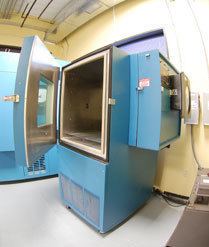 | ||
An environmental chamber, also called climatic chamber or climate chamber, is an enclosure used to test the effects of specified environmental conditions on biological items, industrial products, materials, and electronic devices and components.
Contents
Such a chamber can be used:
- as a stand-alone test for environmental effects on test specimens
- as preparation of test specimens for further physical tests or chemical tests
- as environmental conditions for conducting testing of specimens
Overview
An environmental test chamber artificially replicates the conditions under which machinery, materials, devices or components might be exposed. It is also used to accelerate the effects of exposure to the environment, sometimes at conditions not actually expected.
These conditions may include:
Manufactured samples, specimens, or components are placed inside the chamber and subjected to one or more of these environmental parameters to determine reliability or measure after-effects such as corrosion. In the case of machinery such as internal combustion engines, byproducts such as emissions are monitored.
An environmental chamber can be a small room used both to condition test specimens and to conduct the test. It can be a smaller unit that's used for conditioning test items. Also, some chambers are small enough to be placed onto a universal testing machine or other test apparatus.
Many chambers are set at a certain set of conditions. Others can be programmed to cycle through specified sequences of conditions.
Design
As test requirements may be relatively simple or complex, environmental test chambers vary widely in size, ranging from small units designed for placement on bench tops to large walk-in chambers. Test chambers generally have viewports or video feeds to allow for visual inspection of the sample during the test. Reach-in chambers provide an opening that technicians may use to handle test samples. Chambers providing interior visual lighting must take into account the heat generated and compensate accordingly.
As with the wide variance in size, a number of user control options are available, ranging from simple analog indicators up to more modern digital readouts with LCD displays. Chambers may be computer programmable, and networked or Web-enabled test chambers are also available.
Types of test chambers
Test chamber standards
Several standards organizations provide standards and guidance on environmental test chamber construction, temperature control standards, and engineering tolerances.
